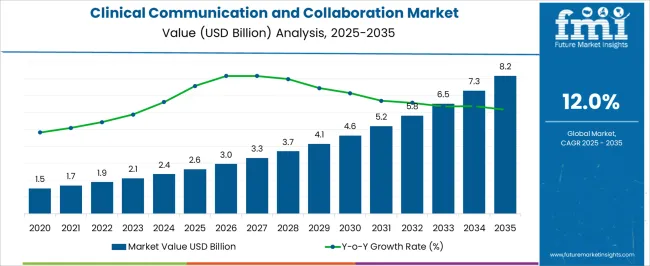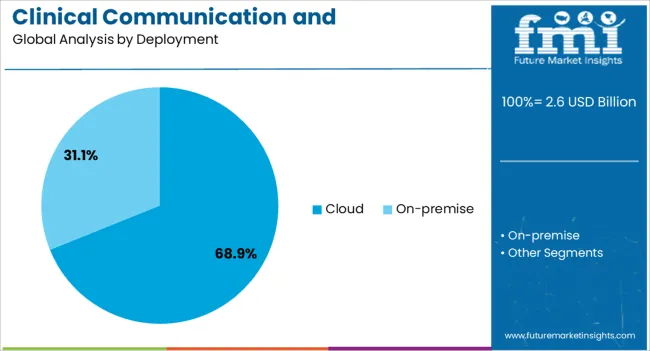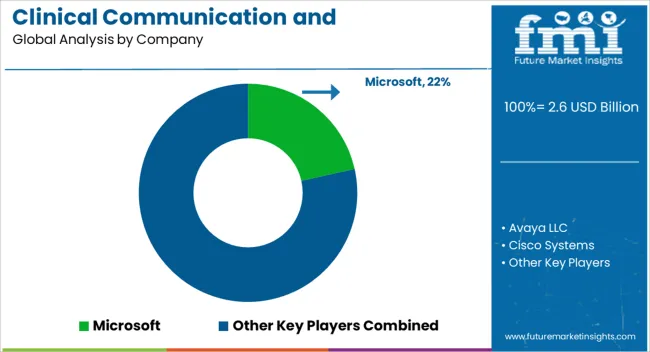The Clinical Communication and Collaboration Market is estimated to be valued at USD 2.6 billion in 2025 and is projected to reach USD 8.2 billion by 2035, registering a compound annual growth rate (CAGR) of 12.0% over the forecast period. The clinical communication and collaboration market is projected to generate an absolute dollar opportunity of USD 5.6 billion over the forecast period. This growth is supported by a robust CAGR of 12%, driven by increasing demand for efficient communication tools, mobile healthcare solutions, and collaboration platforms in the healthcare industry.
In the first five-year phase (2025–2030), the market is expected to expand from USD 2.6 billion to USD 4.3 billion, adding USD 1.7 billion, which accounts for 30.4% of the total incremental growth, as digital health solutions become more integrated into daily clinical workflows. The second phase (2030–2035) contributes USD 3.9 billion, representing 69.6% of the total growth, reflecting stronger momentum as healthcare systems adopt integrated communication and collaboration technologies on a global scale. Annual increments will rise from USD 0.3 billion in early years to USD 1 billion by 2035, driven by advancements in cloud-based solutions, telemedicine, and AI-powered platforms. Manufacturers focusing on interoperability, security, and user-friendly features will capture the largest share of this USD 5.6 billion opportunity.

| Metric | Value |
|---|---|
| Clinical Communication and Collaboration Market Estimated Value in (2025 E) | USD 2.6 billion |
| Clinical Communication and Collaboration Market Forecast Value in (2035 F) | USD 8.2 billion |
| Forecast CAGR (2025 to 2035) | 12.0% |
The clinical communication and collaboration market is advancing rapidly as healthcare providers seek to improve coordination and efficiency across care teams. The growing complexity of patient care and the need for real-time communication have increased demand for integrated communication solutions.
Healthcare systems are prioritizing streamlined information flow to reduce errors and enhance patient outcomes. Advances in digital health technologies have made cloud-based platforms more accessible and scalable, offering secure data sharing and remote collaboration capabilities.
Additionally, hospitals have been the primary adopters of these technologies to support multidisciplinary care and emergency response. Government initiatives promoting healthcare IT modernization and interoperability have further accelerated market growth. Future opportunities are expected to emerge from AI-driven communication tools and enhanced mobile accessibility. Segmental growth is expected to be driven by solution components, cloud deployment models, and hospital end users, reflecting their critical roles in transforming clinical workflows.
The clinical communication and collaboration market is segmented by component, deployment, end-use, and geographic regions. By component, the clinical communication and collaboration market is divided into solutions and services. In terms of deployment, the clinical communication and collaboration market is classified into Cloud and On-premise.
Based on end-use, the clinical communication and collaboration market is segmented into hospitals, Clinical Labs, Physicians, and Others. Regionally, the clinical communication and collaboration industry is classified into North America, Latin America, Western Europe, Eastern Europe, Balkan & Baltic Countries, Russia & Belarus, Central Asia, East Asia, South Asia & Pacific, and the Middle East & Africa.

The Solution segment is projected to contribute 54.2% of the market revenue in 2025, remaining the dominant component category. Growth has been driven by the increasing need for comprehensive platforms that integrate messaging, alerts, video conferencing, and task management in a single interface.
Healthcare providers favor solutions that enhance collaboration, reduce communication delays, and support compliance with patient privacy regulations. The rise of telehealth and virtual care has further expanded demand for robust clinical communication solutions.
Continuous improvements in user experience and interoperability have encouraged wider adoption across various healthcare settings. As the focus on coordinated care intensifies, the Solution segment is expected to maintain its leading market position.

The Cloud deployment segment is expected to hold 68.9% of the market revenue in 2025, leading other deployment models. This growth is due to the flexibility scalability and cost-effectiveness offered by cloud-based platforms.
Healthcare organizations have favored cloud deployments to enable remote access, simplify IT infrastructure, and facilitate rapid software updates. Cloud solutions support seamless integration with existing electronic health records and other clinical systems enhancing workflow efficiency.
The shift towards value-based care and population health management has underscored the importance of data-driven decision-making supported by cloud platforms. As cybersecurity measures improve, cloud adoption in healthcare communication is anticipated to expand further, reinforcing the segment’s dominance.

The Hospital segment is projected to contribute 44.7% of the clinical communication and collaboration market revenue in 2025, maintaining its leadership among end users. Hospitals have been early adopters of clinical communication technologies to manage complex care coordination involving multiple departments and specialists.
The high patient volumes and acuity levels in hospitals demand reliable real-time communication tools to support clinical decision-making and emergency response. Investments in hospital IT infrastructure and the integration of clinical workflows have driven demand for communication solutions tailored to inpatient settings.
Additionally, the growing emphasis on patient safety and regulatory compliance has necessitated effective collaboration platforms. As hospitals continue to digitalize care delivery, the Hospital segment is expected to sustain its significant market share.
The clinical communication and collaboration market is driven by the increasing need for efficient communication in healthcare settings. Opportunities in expanding healthcare infrastructure and digitalization are fueling growth, while trends in AI-driven communication solutions are reshaping the industry. However, high implementation costs and integration complexities may limit adoption. By 2025, overcoming these challenges through affordable solutions and improved integration processes will be crucial for sustained market expansion.
The clinical communication and collaboration market is expanding due to the rising demand for efficient communication solutions in healthcare settings. As hospitals and healthcare providers seek to streamline communication among healthcare professionals, solutions that improve collaboration, reduce errors, and enhance patient care are in high demand. By 2025, the need for real-time communication tools and collaborative platforms will continue to grow, particularly in large medical facilities and multi-disciplinary healthcare teams.
Opportunities in the clinical communication and collaboration market are increasing with the expansion of healthcare infrastructure and digitalization. As healthcare providers integrate digital technologies into their operations, there is a growing demand for advanced communication systems that support telemedicine, remote monitoring, and integrated care. By 2025, these factors will drive the growth of digital platforms designed to improve patient care, communication, and overall healthcare efficiency.
Emerging trends in the clinical communication market include the integration of artificial intelligence (AI) into communication systems. AI-driven tools that assist in decision-making, automate administrative tasks, and facilitate data-sharing are gaining traction. These systems are expected to improve both the speed and accuracy of communication within clinical environments, further enhancing collaboration among healthcare teams. By 2025, AI and machine learning are likely to play an integral role in shaping the future of clinical communication systems.
Despite growth, challenges related to high implementation costs and integration complexity persist in the clinical communication and collaboration market. Healthcare organizations face significant upfront costs when adopting new communication platforms, particularly in terms of training staff and integrating systems with existing infrastructure. These challenges can deter smaller healthcare providers from investing in advanced communication technologies. By 2025, addressing these barriers with affordable solutions and simplified integration processes will be key for market expansion.

| Country | CAGR |
|---|---|
| China | 0.2% |
| India | 0.2% |
| Germany | 0.1% |
| France | 0.1% |
| UK | 0.1% |
| USA | 0.1% |
| Brazil | 0.1% |
The global clinical communication and collaboration market is projected to grow at a 12% CAGR from 2025 to 2035. China leads with a growth rate of 16.2%, followed by India at 15%, and Germany at 13.8%. The United Kingdom records a growth rate of 11.4%, while the United States shows the slowest growth at 10.2%. These varying growth rates are driven by the increasing adoption of digital healthcare solutions, rising demand for real-time communication tools in healthcare settings, and the growing need for collaboration platforms in clinical environments. Emerging markets, such as China and India, are experiencing higher growth due to rapid expansion of healthcare infrastructure, digitization, and the push for improved patient care. In contrast, more mature markets, such as the USA and the UK, are seeing steady growth driven by healthcare digital transformation and regulatory standards. This report includes insights on 40+ countries; the top markets are shown here for reference.
The clinical communication and collaboration market in China is growing at a robust pace, with a projected CAGR of 16.2%. China’s rapidly expanding healthcare sector, coupled with the government’s push toward healthcare digitization, is driving significant demand for communication and collaboration platforms in clinical environments. The increasing adoption of electronic health records (EHR) and telemedicine solutions, along with a rising focus on improving patient care and operational efficiency, is contributing to the demand for these platforms. Additionally, China’s large population, growing healthcare infrastructure, and emphasis on healthcare accessibility further accelerate market growth.
The clinical communication and collaboration market in India is projected to grow at a CAGR of 15%. India’s growing healthcare sector, particularly the increasing adoption of digital health solutions and telemedicine, is significantly contributing to the demand for communication and collaboration platforms in clinical settings. The country’s rising focus on improving patient care, enhancing operational efficiency, and overcoming challenges in healthcare accessibility is further driving market growth. Additionally, India’s growing number of healthcare facilities and increasing investments in health technology innovations are accelerating the adoption of clinical communication tools.

The clinical communication and collaboration market in Germany is projected to grow at a CAGR of 13.8%. Germany’s advanced healthcare system, combined with its strong focus on healthcare digital transformation, is driving demand for communication and collaboration tools in clinical environments. The increasing integration of EHR, telemedicine, and telehealth solutions in healthcare settings is contributing to the adoption of these platforms. Additionally, Germany’s stringent healthcare regulations and commitment to improving patient outcomes through efficient communication further accelerate the market for clinical collaboration technologies.
The clinical communication and collaboration market in the United Kingdom is projected to grow at a CAGR of 11.4%. The UK’s established healthcare system, with a growing emphasis on improving healthcare delivery through digital solutions, is contributing to steady market growth. The integration of EHR systems, mobile communication tools, and telemedicine services in clinical settings is accelerating the demand for clinical collaboration platforms. Additionally, the UK government’s push toward better healthcare accessibility and the adoption of real-time communication solutions in hospitals and healthcare facilities further drive the market expansion.

The clinical communication and collaboration market in the United States is expected to grow at a CAGR of 10.2%. The USA healthcare system continues to adopt digital solutions to enhance patient care, streamline operations, and improve healthcare accessibility. The integration of mobile communication tools, telemedicine, and EHR solutions into clinical workflows is driving demand for collaboration platforms. Additionally, regulatory requirements and the increasing emphasis on improving patient outcomes through efficient and timely communication are accelerating the adoption of clinical communication technologies in the USA healthcare settings.

The clinical communication and collaboration market is dominated by Microsoft, which leads with its robust suite of collaboration tools, including Microsoft Teams, designed to improve communication and coordination within healthcare organizations. Microsoft’s dominance is reinforced by its strong cloud infrastructure, integration capabilities, and widespread adoption across various industries, including healthcare. Key players such as Avaya LLC, Cisco Systems, and Intel Corporation maintain significant market shares by offering specialized communication solutions tailored to the unique needs of the healthcare sector, including voice over IP (VoIP), video conferencing, and secure messaging systems. These companies focus on enhancing real-time collaboration, improving patient care, and ensuring compliance with healthcare regulations. Emerging players like NEC Corporation, Oracle, and Plantronics, Inc. are expanding their market presence by providing customized clinical communication solutions that address specific challenges such as remote patient monitoring, telehealth, and secure communication channels for medical professionals. Their strategies include improving data security, integrating artificial intelligence, and offering scalable solutions for healthcare facilities of all sizes. Market growth is driven by the increasing adoption of digital health solutions, the rise in telemedicine, and the need for secure, real-time communication within healthcare settings. Innovations in AI-powered collaboration tools, voice recognition, and cloud-based communication platforms are expected to continue shaping competitive dynamics and fuel further growth in the global clinical communication and collaboration market.
| Item | Value |
|---|---|
| Quantitative Units | USD 2.6 Billion |
| Component | Solution and Services |
| Deployment | Cloud and On-premise |
| End-Use | Hospital, Clinical Labs, Physicians, and Others |
| Regions Covered | North America, Europe, Asia-Pacific, Latin America, Middle East & Africa |
| Country Covered | United States, Canada, Germany, France, United Kingdom, China, Japan, India, Brazil, South Africa |
| Key Companies Profiled | Microsoft, Avaya LLC, Cisco Systems, Intel Corporation, NEC Corporation, Oracle, and Plantronics, Inc. |
| Additional Attributes | Dollar sales by communication tool type and application, demand dynamics across healthcare providers, hospitals, and telemedicine sectors, regional trends in clinical communication and collaboration adoption, innovation in secure messaging and real-time collaboration technologies, impact of regulatory standards on data privacy and interoperability, and emerging use cases in remote patient monitoring and AI-assisted healthcare delivery. |
The global clinical communication and collaboration market is estimated to be valued at USD 2.6 billion in 2025.
The market size for the clinical communication and collaboration market is projected to reach USD 8.2 billion by 2035.
The clinical communication and collaboration market is expected to grow at a 12.0% CAGR between 2025 and 2035.
The key product types in clinical communication and collaboration market are solution, _secure messaging platform, _electronic health record (ehr) systems, _telehealth platform, _collaborative care platforms, _others, services, _integration & implementation, _consulting services and _support & maintenance.
In terms of deployment, cloud segment to command 68.9% share in the clinical communication and collaboration market in 2025.






Full Research Suite comprises of:
Market outlook & trends analysis
Interviews & case studies
Strategic recommendations
Vendor profiles & capabilities analysis
5-year forecasts
8 regions and 60+ country-level data splits
Market segment data splits
12 months of continuous data updates
DELIVERED AS:
PDF EXCEL ONLINE
Clinical Communication & Collaboration Software Market Trends – Forecast through 2034
Clinical Chairs Market Size and Share Forecast Outlook 2025 to 2035
Clinical Avian Nutrition Market Analysis - Size, Share, and Forecast Outlook 2025 to 2035
Clinical Workflow Solution Market Size and Share Forecast Outlook 2025 to 2035
Clinical Trials Support Software Solutions Market Size and Share Forecast Outlook 2025 to 2035
Clinical Research Organization Market Size and Share Forecast Outlook 2025 to 2035
Clinical Trial Packaging Market Size and Share Forecast Outlook 2025 to 2035
Clinical Mobility Market Size and Share Forecast Outlook 2025 to 2035
Clinical Immunodiagnostics Market Size and Share Forecast Outlook 2025 to 2035
Clinical Oncology Next-generation Sequencing Market Analysis - Size, Share, and Forecast 2025 to 2035
Clinical Decision Support Systems Market Size and Share Forecast Outlook 2025 to 2035
Clinical Trials Market Analysis - Size, Share, and Forecast 2025 to 2035
Clinical Refractometer Market Size and Share Forecast Outlook 2025 to 2035
Clinical Next-Generation Sequencing (NGS) Data Analysis Market Analysis by Solution and Services, Technology, End User, and Region through 2035
The Clinical Alarm Management Market is segmented by component, deployment mode and end user from 2025 to 2035
Clinical Nutrition Market Insights – Trends & Forecast 2025 to 2035
Clinical Diagnostics Market Insights – Size, Share & Forecast 2025 to 2035
Clinical Information System Market Analysis - Growth & Forecast 2024 to 2034
Clinical Chemistry Analyzers Market Trends – Demand & Forecast 2024 to 2034
Clinical Decision Support App Market – AI-Powered Insights 2034

Thank you!
You will receive an email from our Business Development Manager. Please be sure to check your SPAM/JUNK folder too.
Chat With
MaRIA